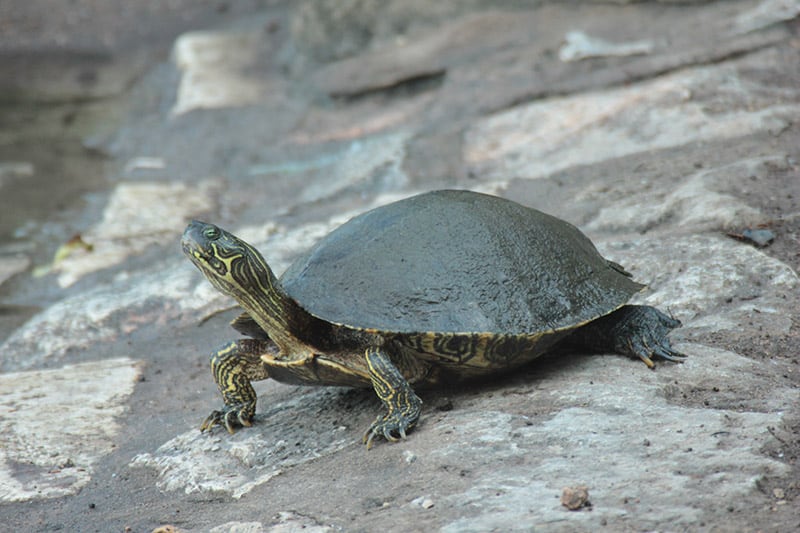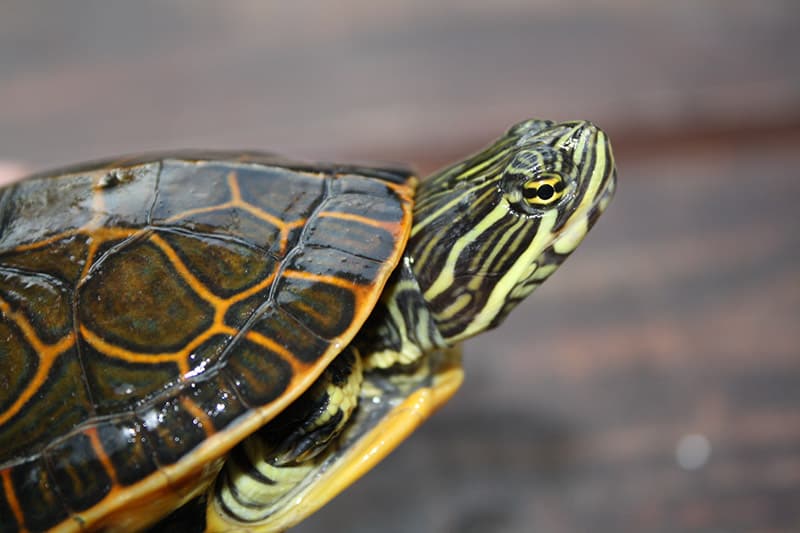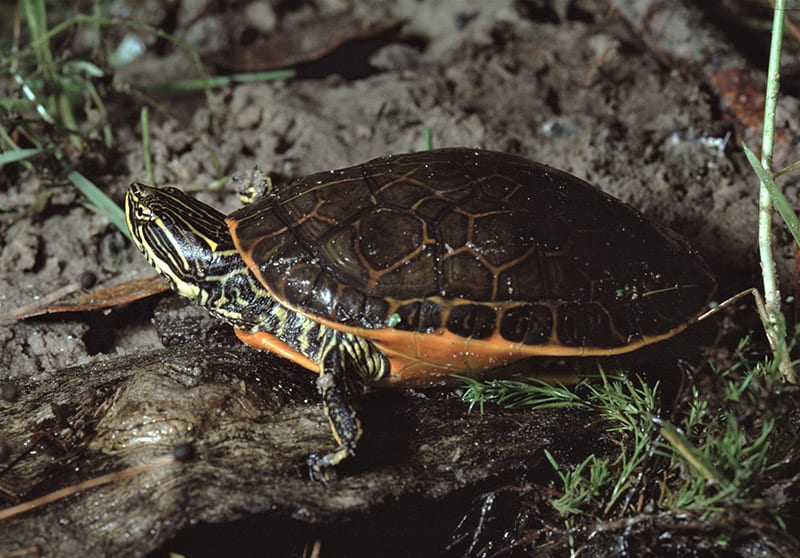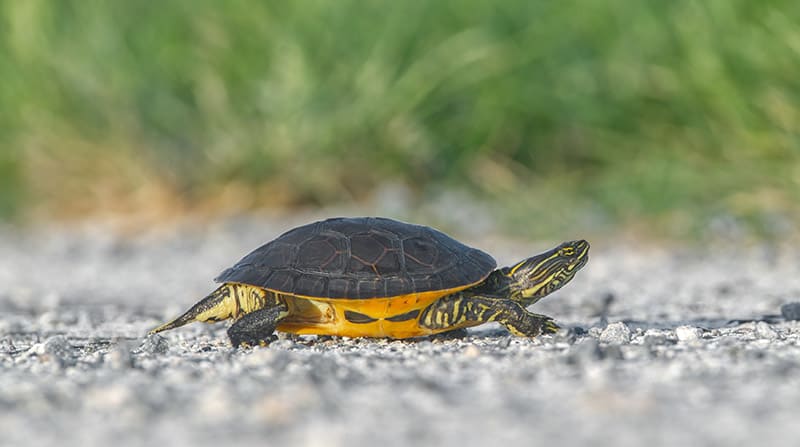Not only is the Chicken Turtle good-looking, but it has an alert and inquisitive nature!
The Chicken Turtle has a beautiful reticulated shell and vertically striped rump. Its good looks along with its attentive nature are some of its endearing qualities. The name ‘chicken turtle’ unfortunately comes from the early days when these turtles were eaten in very large numbers throughout the southeastern United States. They are said to be quite good, tasting “like chicken.”
Chicken turtles are good captives. They are baskers, very shy and alert, plopping into the water at the approach of their keeper. They will soon become tame and though they will dive off into the water, they will quickly re-surface to see if any food has been offered. They do get larger than most first-time pet buyers realize however, with adult females reaching 11-12″ inches within five or six years.
- For more information see: Selecting and Caring for Your Turtle or Tortoise
Scientific Classification
| Kingdom: | Animalia |
| Phylum: | Chordata |
| Class: | Reptilia |
| Order: | Testudines |
| Family: | Emydidae |
| Genus: | Deirochelys |
| Species: | reticularia |
Distribution
The Chicken Turtle Deirochelys reticularia was described by Latreille in 1801. They are found from from Virginia south to Florida and west to Missouri, Oklahoma, and Texas. Chicken turtles are found in still waterways in nature. They inhabit ponds, lakes, and swamps and rarely fast-flowing rivers or streams, and sometimes wander on land.
Besides the nominate form, the Eastern Chicken Turtle D. r.reticularia there are two additional subspecies of the Chicken Turtle. They are the Florida Chicken Turtle D. r. chrysea and the Western Chicken Turtle D. r. miaria, both of which were described by Schwartz in 1956.

Status
These turtles are not listed on the IUCN Red List.
Description
The Chicken Turtles have unusually long necks and large, inquisitive eyes. Their shells vary but many have amazingly beautiful green and yellow whirls and rings. They have a yellow plastron and a characteristic vertically striped rump. Adult female chicken turtles can grow to 12″, with mature males being slightly smaller.
Care and Feeding
Chicken turtles exhibit the typical change in feeding patterns seen in many freshwater turtles. Hatchling and young turtles feed on aquatic insects, tadpoles, and crayfish. As they grow they will tend to move toward a more omnivorous diet, and begin to eat more and more plant material. In captivity they are enthusiastic feeders on commercial turtle diets, fish, and invertebrates, and will also eat aquatic plants such as water lettuce, water hyacinth, watercress, and romaine lettuce, kale, carrot tops, and other greens.
Care must be taken that these, and any turtles, are not released into a wild habitat. The reasons are many. The introduction of non-native species can lead to the introduction of diseases and can lead to hybridization of introduced and native species. In addition, many turtles raised in captivity and released into wild situations are confused, unable to cope with extreme weather changes, and many surely fall prey quite quickly to the wary predators they may encounter.

Environment
Chicken turtles are found in still waterways in nature. They inhabit ponds, lakes, and swamps and rarely fast-flowing rivers or streams. In captivity they thrive in a habitat with clean, aerated water with plenty of basking spots. They love to bask together in groups so be sure to offer them a large branch, piece of driftwood, or pile of stones.
They thrive in outdoor ponds, but they will hibernate. Care must be taken to formulate a plan for a moderately cool hibernation area. The Florida Chicken Turtle D. r. chrysea may be kept healthy with only a mild cooling or resting period. The two more temperate subspecies, the Eastern Chicken Turtle D. r. reticularia and the Western Chicken Turtle D. r. miaria, can be safely hibernated and indeed probably need the hibernation period to inspire courtship and mating in the spring and early summer.
Indoors, a basic setup in a large tub (48″w x 84″l x 20″deep) or stock tank will be sufficient to keep and breed an adult trio of chicken turtles. Add an efficient filtration system, a shop light fixture with UVB-emitting bulbs overhead, and a warm basking spot as chicken turtles are avid baskers. Add driftwood and bunches of submerged and floating plants to their enclosure.
Breeding
In warmer climates, Chicken Turtles will lay multiple clutches of from 6 to 10 eggs. These eggs will hatch in 75 to 85 days depending on the incubation temperature. A recommended safe incubation temperature for obtaining a mixed ratio of male and female hatchlings is 82° F with 75% to 85% humidity.
Baby Chicken Turtles should be set up in an aquarium with 3-4″ of clean, filtered water and with plenty of driftwood, flat stones, and aquatic plants. Babies are a little more delicate than slider babies but even the most finicky babies will usually begin feeding on mosquito larvae, blackworms, small guppies.
Ailments / Health Problems
Not many, but shell and skin infections will arise in specimens kept in stagnant or dirty water. These and all turtles should be fed a varied diet consisting of thawed fish, worms, insects, plants, and commercial diets. Feeding only commercial turtle pellets will lead to obesity, fixation on a single food source, and even kidney stones, fatty livers, and other medical conditions leading to death. Ear abscesses occur from poor water quality and specimens kept in too cold conditions.

Availability
Chicken Turtles are available from sources such as better pet stores and breeders at the larger reptile shows across the country. There are several dealers on-line selling wild-caught Chicken Turtles. We suggest that a new keeper try to find specimens that are captive-hatched and at least six to eight months old to ensure the turtle has been feeding well and is well on its way to a strong start.
Featured Image Credit: Chase Danimulls, Shutterstock
